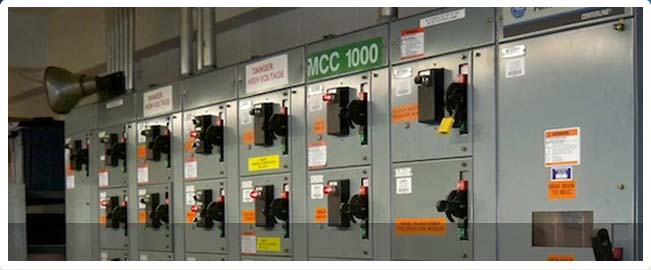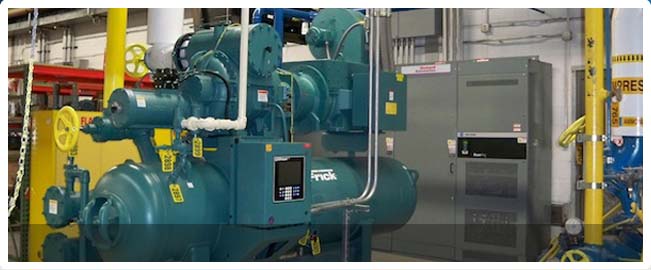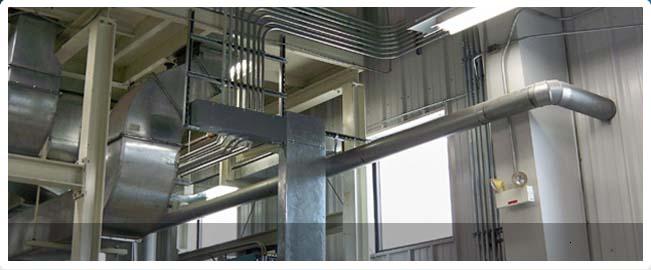POWER FACTOR CORRECTION
What is Power Factor?
Power factor is a measurement of how effectively electrical power is being used. An industrial electrical contractor should be familiar with this. A high power factor (near 1.0), indicates efficient utilization of electrical power, while a low power factor indicates poor utilization of electrical power. Many utility companies will charge a power factor penalty if your power factor falls below 0.90. Power factor is the ratio of real power (or watts) to the apparent power (or volt-amperes). Power factor is calculated by dividing the real power by the apparent power.
What Causes Low Power Factor?
On of the main causes of low power factor is inductive motor loads that are operated at less than full load. This often occurs when the motor is not under a constant, full load such as surface grinders, conveyors, air compressors, circular saws, punch presses, and plastic injection molding machines. The motors on these types of equipment are sized for the heaviest load, even though they are frequently operated at no load or less than full capacity. Examples are a lightly loaded conveyor, a saw spinning without cutting, or a surface grinder performing a shallow cut.
Inductive motor loads require the production of a magnetic field in order to facilitate their operation. Inductive loads require two kinds of current: real power, kW, to perform the actual work of creating motion and machine output as well as reactive power, kVAR, to sustain the electromagnetic field. Real power consumes watts and can be read on a wattmeter, and is measured in kilowatts, kW. Reactive power doesn? do useful ?ork and circulates between the generator and the load. It places a burden on the power source as well as the power distribution system. Reactive power is measured in kilovolt-amperes-reactive (kVAR). Real power and reactive power together make up apparent power. Apparent power is measured in kilovolt-amperes (kVA).
Why Should I Be Concerned About Low Power Factor?
Utility companies are concerned about the relationship between Real Power and Apparent Power because the system is built based on kVA and billed to the customer based on kW. For example, transformers are sized in kVA (apparent power) and utility company meters (and therefore bills) measure kilowatt hours and kW of demand (real power). Utility companies justify power factor penalties because poor factor requires a physically larger installation than would otherwise be required. For example, if you have a power factor of .70, the utility company must size their supply system 30% larger than if your power factor was 1.0.
In large industrial facilities with significant power consumption, utility company penalties can be significant, amounting to hundreds or thousands of dollars per month. Your utility bill can be analyzed to determine the full extent of the power factor penalty. In fact, companies can obtain the history of billing from the utility company to profile the last twelve months of consumption and associated power factor penalties. Keep in mind that not all commercial or industrial facilities are billed for poor power factor. However, do not depend on your utility company to inform you that they are including a power factor penalty on your utility bill. Utility companies billing for power factor penalty is like the proverbial fox watching the chicken coop.
In addition to eliminating utility company penalties, correcting low power factor by installing power capacitors can add capacity back into the power distribution system. Load on transformers can be reduced by the installation of power capacitors because raising the power factor on a kW load reduces kVA. By adding capacitors, you can add additional kW load to the power distribution system without altering the kVA.
The addition of capacitors can also have a positive impact on system voltage drop because of the decrease in current and its relationship to the distance that power must travel through the distribution system. In other words, a capacitor installed at the end of a long feeder or run of bus duct will have the impact of improving voltage from its point of installation back to the main service.
What Can I Do To Improve Power Factor?
The power factor of the standard induction motor is seldom greater than .95 and often falls to as low as .60 or lower when the induction motor is lightly loaded. Synchronous motors can be used to correct low power factor. Unlike the induction motor, the power factor of a synchronous motor is not dependant upon its design and load. The power factor of a synchronous motor is dependant on the value of the direct field current and can be adjusted by the operator. Synchronous motors can be installed with a leading power factor to counteract the lagging power factor of induction motors. However, synchronous motors do not have the broad application of induction motors, and are, therefore, rarely, if ever, used to correct low power factor in modern plants.
Low power factor is most often improved by adding power capacitors to your plant distribution system. Power factor correction capacitors are capacitors with relatively large values of capacity, which are used on power distribution systems in industrial plants for improving power factor. Power capacitors act as reactive current generators. By providing reactive current (kVAR), power capacitors reduce the total amount of current the power distribution system must draw from its source.
Power capacitors are connected across the line to neutralize the effect of lagging power factor loads and thus reduce the current for a given kilowatt load. Capacitors can be installed at the individual motor loads or they can be grouped and installed at one point and connected across the main power distribution. Greater effect will result with the capacitors directly located at each individual motor because the current is thereby reduced all the way from the load to the source. However, connecting capacitors at the individual loads has greater initial cost and must be weighed against the cost of grouping the capacitors in one location. Generally speaking, the best return on investment is achieved when the capacitors are grouped at a single location.
What Are Some Tips For the Installation of Power Capacitors?
Power capacitors are static devices that have no moving parts, and normally require little or no maintenance. Capacitors should be equipped with fuses, and Cooper Electric recommends blown-fuse indicator lights that will illuminate in the event that a fuse is blown. A properly sized installation should not blow a fuse. However, harmonic currents (discussed in the next two paragraphs) that might be introduced into the plant unbeknownst to the maintenance staff could blow these fuses. The blown-fuse indicator lights on the power capacitors can be an early warning sign of the existence of harmonic currents.
Installation of power capacitors in modern plants can be complicated by the presence of harmonic currents that are created by non-linear loads. Non-linear loads use current in pulses and at a frequency other than 60Hz. The most common non-linear loads are variable frequency drives. Care must be taken so that harmonic currents caused by variable frequency drives do not destroy the power capacitors.
Harmonic currents can be thought of as a virus in the electrical system and can cause great difficulties. Harmonic currents are specific to each individual facility, and are difficult if not impossible to calculate or predict. Therefore, a field-measurement to check for the presence of harmonic currents is recommended. To get a good measurement of harmonic currents, instruments that record harmonic currents over several days are also recommended. If you merely go in and measure the current at one point it time, all you have is a snapshot, and this may not reflect the existence of harmonic currents that may be present at other times. Cooper Electric recommends doing a power quality survey before the installation of capacitors. If there are sufficient harmonic currents, it may become necessary to install filters tuned to specific harmonic current frequencies in order to properly protect power capacitors. Cooper Electric will work with you to ensure that you achieve the benefits of power factor correction capacitors despite the harmonics generated by modern plant equipment.
Power capacitor cases are normally warm to the touch. If the case does not feel warm, you should check for blown fuses or an open power source. The power being fed into capacitors can be checked with a true-reading rms clamp around ammeter. Capacitors applied at 480 volts will draw 1.2 amps per kVAR. Correspondingly, capacitors applied at 240 volts will draw 2.4 amps per kVAR.
When capacitors are installed on the load side of motor starters, it is necessary to adjust the overload heater elements in the motor starter. You should consult the capacitor manufacturer? recommendations for the appropriate sizing of the motor overload protection.
Large banks of static, across-the-line installed capacitors can create an objectionable voltage rise on the system when there is a light or no load condition such as weekend or night when the plant has reduced operation. The simplified voltage rise can be calculated using the kVARs of capacitance, percentage of transformer reactance, and transformer kVA. You can consult the manufacturer of the capacitors for the specific equation to determine the simplified voltage rise.
Due to the fact that large banks of static, across-the-line capacitors can create objectionable voltage rises in the system, it is often necessary to install a controller that automatically adds capacitance as needed. Commercial electricians know the automatic capacitor continually monitors the power factor and adds capacitors on-line only as needed to prevent objectionable voltage rise.
Based on the seven paragraphs under the TIPS heading, it should be obvious that collaborating on your capacitor installation with an experienced and trusted electrical contractor like Cooper Electric can save time and money. In business over 63 years, our customers can expect Cooper Electric to service their needs, perform high quality work that is guaranteed, answer their questions, provide direction and offer advice. Please do not hesitate to call our office at (513-271-5000).




